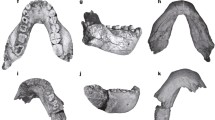Abstract
The first Diplothrix (Muridae, Rodentia) fossils of the early Early Pleistocene are described as D. yangziensis sp. nov., which were collected from the Renzidong Cave deposits in Anhui Province, Eastern China. Diplothrix was previously represented by a single species, D. legata, whose geographical distribution during the Late Pleistocene is restricted to the Ryukyu Islands, Japan. With straight chevrons on M1, distinct t3 and t9 on upper molars, primitive M3, mlc on m1, and developed a-lab on m2 and m3, the new species is morphologically distinct from other large murids in East Asia, and should belong to the genus Diplothrix. There are also differences in molar morphology between the new species and D. legata, the type species of Diplothrix, as well as other known fossils. For example, D. yangziensis sp. nov. has a smaller size, a more elongated crown, developed precingulum and pc on M1, more primitive M3, weaker mlc and more primitive pc on m1, and stronger plc and pc on m3. In short, Diplothrix yangziensis sp. nov. is evidently more primitive than D. legata, suggesting that the former is likely the ancestor of the latter. Diplothrix yangziensis sp. nov. is the first discovery of the genus outside the Ryukyu Islands, Japan and is also the earliest and most primitive species of the genus in Eurasia. Its discovery has significant implications for reconstructing the evolution and dispersal pattern of Diplothrix, as well as for discussing its palaeoecological variation.
Similar content being viewed by others
References
Abe H, Ishii N, Kaneko Y, et al. A Pictorial Guide to the Mammals of Japan (in Japanese). Tokyo: Tokai University Press, 1994. 107
Sato J J, Suzuki H. Phylogenetic relationships and divergence times of the genus Tokudaia within Murinae (Muridae, Rodentia) inferred from the nucleotide sequences encoding the Cytb, RAG 1 and IRBP. Can J Zool, 2004, 82: 1343–1351
Jin C Z, Dong W, Liu J Y, et al. A preliminary study on the Early Pleistocene deposits and the mammalian fauna from the Renzi Cave, Fanchang, Anhui, China. Acta Anthropol Sin, 2000, (Suppl 19): 229–239
Jin C Z, Liu J Y. Paleolithic Site — the Renzidong Cave, Fanchang, Anhui Province. Beijing: Science Press, 2009. 1–439
Wang Y, Jin C Z. Fossil Diplothrix (Diplothrix sp. nov., Muridae) from Renzidong Cave, Fanchang, Anhui province, China. In: Dong W, ed. Proceedings of the 11st Annual Meeting of the Chinese Society of Vertebrate Paleontology. Beijing: China Ocean Press, 2008. 65–71
Musser G G. Results of the Archbold Expeditions No.105. Notes on systematics of Indo-Malayan murid rodents and descriptions of new genera and species from Ceylon, Sulawesi and the Philippines. Bull Amer Mus Nat Hist, 1981, 168: 225–334
Yang A F, Wang P. The Anatomic Structure of Murids (in Chinese). Beijing: Science Press, 1985. 15–16
Otsuka H. Paleovertebrate fauna of the Ryukyu Archipelago and its origin (in Japanese). In: Kimura M, ed. The Formation of the Ryukyu Arc and Migration of Biota to the Arc. Naha: Ryukyu Times, 2002. 111–127
Otsuka H, Takahashi A. Pleistocene vertebrate faunas in the Ryukyu Islands: their migration and extinction. In: The international Symposium on the Ryukyu Islands (Kagoshima). In: Otsuka H, ed. Tropics, 2000, 10: 25–40
Kawamura Y. Quaternary rodent faunas in the Japanese Islands (Part 2). Mem Fac Sci, Kyoto Univ Ser Geol Mineral, 1989, 102–110
Zheng S H. Quaternary Rodents of Sichuan-Guizhou Area, China. Beijing: Science Press, 1993. 125–205
Musser G G, Brothers E M. Identification of Bandicoot rats from Thailand (Bandicota, Muridae, Rodentia). Amer Mus Novit, 1994, 110: 1–55
Hao S D, Huang W B. Luobidong Cave Site. Haikou: South Press, 1998. 67–72
Thomas O. On a second species of Linothrix from the Liu Kiu Islands. Ann Mag Nat Hist, 1906, 52: 88–89
Thomas O. On Muridae from Darjiling and the Chin Hills. J Bombay Nat Hist Soc, 1916, 24: 404–415
Kowalski K, Hasegawa Y. Quaternary rodents from Japan. Bull Nat Sci Mus Tokyo, 1976, 2: 44–45
Tomida Y, Otsuka H. A synopsis of a vertebrate paleontological and paleoanthropological survey on the island of Tokuno and the big island of Amami. Mem Nat Sci Mus, 1990, 23: 173–183
Oshiro I, Nohara T. Distribution of Pleistocene terrestrial vertebrates and their migration to faunas the Ryukyus. In: The International symposium on the Ryukyu Islands (Kagoshima). In: Otsuka H, ed. Tropics, 2000, 10: 41–50
Author information
Authors and Affiliations
Corresponding author
About this article
Cite this article
Wang, Y., Jin, C. & Wei, G. First discovery of fossil Diplothrix (Muridae, Rodentia) outside the Ryukyu Islands, Japan. Chin. Sci. Bull. 55, 411–417 (2010). https://doi.org/10.1007/s11434-009-0541-4
Received:
Accepted:
Published:
Issue Date:
DOI: https://doi.org/10.1007/s11434-009-0541-4




